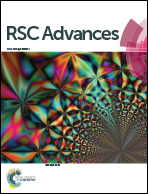Computational study on redox-switchable second-order nonlinear optical properties of ferrocene-tetrathiafulvalene hybrid†
Abstract
Redox-switchable second-order nonlinear optical (NLO) responses of a series of ferrocene-tetrathiafulvalene (Fc–TTF) hybrids have been studied based on density functional theory calculations. The hyper-Rayleigh scattering (HRS) responses as well as the dynamic (λ = 1064 nm) HRS hyperpolarizabilities have been calculated in the gas phase within the T convention. The electron-correlation effects have been investigated. The long-range corrected LC-BLYP and wB97X-D functionals provide satisfactory results. The electron donor strength of the Fc–TTF in a donor-π-conjugated-acceptor structure has been assessed. The results indicate that the Fc unit does not play the role of the electron donor in the Fc–TTF unit. Because the Fc–TTF hybrid unit is a multistep redox center, the one- and two-electron-oxidized processes have been considered to control the second-order NLO responses. For a known Fc–TTF hybrid, one-electron-oxidization leads to a significant increase of the HRS hyperpolarizability, while the calculated HRS hyperpolarizabilities are not affected by the two-electron-oxidization according to our DFT calculations. Interestingly, in another system the two-electron-oxidization significantly enhances the HRS hyperpolarizability, and the one-electron-oxidization does not largely affect the HRS hyperpolarizability.


 Please wait while we load your content...
Please wait while we load your content...